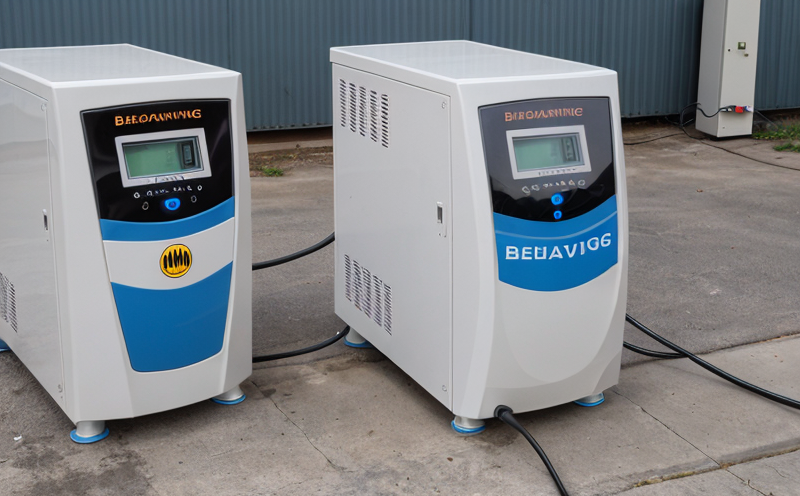IEC 61427 Charging and Discharging Behavior Testing of Batteries for Renewable Energy Storage
The International Electrotechnical Commission (IEC) standard, IEC 61427, is a cornerstone in the evaluation and certification of batteries designed for renewable energy storage systems. This service involves rigorous testing to ensure that batteries perform optimally under various charging and discharging conditions, which are critical for grid stability and reliability.
The primary goal of this testing is to assess how well batteries can handle repeated charge-discharge cycles without degrading performance or compromising safety. By adhering to IEC 61427, manufacturers and developers ensure that their products meet the highest industry standards, thereby enhancing trust among consumers and stakeholders in renewable energy sectors.
The standard covers a wide range of parameters, including temperature cycling, overcharge/overdischarge conditions, and deep discharge tests. These tests simulate real-world usage scenarios to evaluate battery resilience against extreme conditions. The results are essential for selecting the most suitable batteries for specific storage applications like solar power systems or wind energy installations.
One key aspect of this testing is understanding how different charging rates affect battery performance. Charging too fast can lead to thermal runaway, while excessively slow charges may result in inefficient use of resources and increased costs. Discharge behavior also plays a crucial role; sudden high-power discharges are common during peak energy demand periods.
Proper specimen preparation is vital for accurate testing outcomes. This includes ensuring that the battery cells or modules are conditioned to specific temperatures before any tests begin, as stated in IEC 61427. Additionally, it's important to monitor and record all operational parameters throughout each test cycle to capture detailed data.
The instrumentation used during these tests plays a pivotal role in accuracy and reliability. High-precision measurement devices are employed to track voltage levels, current flows, and other critical metrics continuously. Advanced software systems help in analyzing this vast amount of collected data efficiently.
Upon completion of the testing process, comprehensive reports are generated detailing all observed behaviors during charging and discharging phases. These reports serve as valuable tools for both quality managers overseeing production processes and R&D engineers refining future designs based on empirical findings.
In summary, IEC 61427 charging and discharging behavior testing is indispensable for ensuring the longevity, efficiency, and safety of batteries intended for renewable energy storage systems. It provides a robust framework for meeting stringent global standards while fostering innovation within this rapidly evolving sector.
Why It Matters
Battery technology plays an increasingly significant role in the transition towards sustainable energy solutions. The performance of these batteries directly impacts the reliability and efficiency of renewable energy systems, which are crucial for reducing greenhouse gas emissions globally.
- Enhanced Safety: Through thorough testing according to IEC 61427, potential risks associated with battery failures or malfunctions are minimized. This enhances public confidence in adopting new technologies.
- Better Efficiency: Understanding how batteries behave under various charging and discharging conditions allows for optimization of energy management systems, leading to more efficient use of resources.
By adhering to this standard, manufacturers can demonstrate their commitment to quality and sustainability, opening up opportunities for business growth in the competitive renewable energy market.
Benefits
- Increased Reliability: Rigorous testing ensures that batteries perform consistently over time, reducing downtime and maintenance costs.
- Better Performance: By identifying weak points early in the development cycle, manufacturers can improve overall battery performance before product release.
- Compliance Assurance: Meeting IEC 61427 requirements helps companies comply with international standards, broadening market access and enhancing brand reputation.
In addition to these benefits, adherence to this standard contributes significantly to the long-term success of renewable energy projects by ensuring that components are reliable and efficient throughout their lifecycle.
Environmental and Sustainability Contributions
Battery testing according to IEC 61427 not only benefits individual companies but also contributes positively to environmental sustainability. Ensuring the reliability and longevity of batteries reduces waste generation, extends product lifetimes, and supports the circular economy concept.
- Reduced Waste: Longer-lasting batteries mean fewer replacements, thus decreasing electronic waste sent to landfills.
- Eco-Friendly Operations: By optimizing energy usage through better battery management strategies informed by test results, operations become more environmentally friendly.
The continuous improvement of battery technology driven by stringent testing standards like IEC 61427 plays a vital role in advancing sustainable practices across industries reliant on renewable energies.





